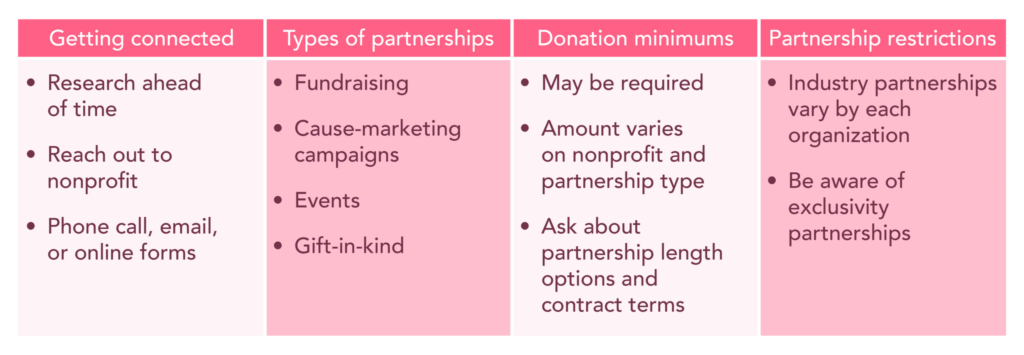


Partnering with a nonprofit can help further your organization’s mission while making a difference in the lives of others. This guide will answer common questions about connecting with a charity and offer best practices for making the most of your partnership. Read on for tips and tools that will make your partnership a success while supporting a great cause!
To find the right nonprofit for your company, it is important to do your own research. Make sure you view charity rating sites to see the charity’s full picture. You can always reach out to organizations and ask questions, clarify information, and create a more personal connection.
How do I know if the organization is a real nonprofit? Nonprofits are registered and must file an IRS Form 990 to be considered a nonprofit organization. To learn more about researching nonprofits and charity ratings, click here.
How can I see other companies they work with? Most nonprofits feature top corporate partners on their websites. Review the brands they partner with to understand the industries and types of companies they work with. During your discussions, you can ask how your company can become featured on their website.
Organizations offer different types of partnerships, and finding the right one for your company is important. Types of partnerships can include fundraising, cause-marketing campaigns, events, and gift-in-kind.
Some partnerships require a minimum donation – these can vary depending on the nonprofit partner and their partnership types and terms. This requirement confirms partners are committed to making a difference in their communities. Minimum donations also ensure the administrative effort to support a thriving partnership is available.
For example, the NBCF Pink Ribbon Partnership does not have a minimum donation, however, the Full Service Partnership requires a minimum annual donation starting at $3,000.
What if the type of partnership I want isn’t listed as an option? If you don’t see the ideal option for your organization, ask the nonprofit if they can customize your partnership.
The length of a partnership can vary – days, weeks, months, or year-round. This is usually determined when signing a partnership contract. Companies always have the option to renew the partnership every year or change the parameters. Ideally, the connection and success will continue to grow with each year!
Nonprofit values, areas of focus, and logistics can determine partnership guidelines.
Examples:
Because of the sensitivity surrounding the health and wellbeing of cancer patients, NBCF does not partner with organizations in tobacco, illicit drugs, and hard alcohol. In addition, NBCF does not partner with organizations in adult entertainment, guns and firearms, controversial animal industries, and book and video recordings.
Are there other types of restrictions? In some cases, nonprofits may limit brands or businesses they partner with. For instance, a nonprofit may decide to only partner with one company in a sector to avoid conflicts between competitors. Other nonprofits might work with companies to create unique campaigns so they don’t overlap with others in their industry.
You don’t have to know every detail of what you want to do before you reach out to a nonprofit. Likely they will want to understand your main goals and what part of the mission resonates most with you. Think of the first outreach as getting the process started. Some companies have all of the details sorted out while others just have a general idea – either is perfectly fine.
Organizations may have preferred forms of contact: phone, email, form, or scheduling a meeting. You can review their website as you prepare to reach out.
What if I don’t hear back? Some charities have busy seasons based on key months or end of year and likely receive larger amounts of calls and emails as those times approach. If you don’t hear back, try reaching out through a phone call.
Pay attention to how timely the response is – this may indicate the overall service they will provide.
In a nutshell, most nonprofits will be thrilled to learn of your interest and grateful for your support. It can be as easy as a call or email to get the conversation started. This initial outreach may turn into a one-time campaign or a lasting connection that raises needed funds, supports community initiatives, and makes a genuine difference in the lives of others.

National Breast Cancer Foundation’s partnership information:
Donations are always appreciated, but there are lots of great ways to get involved.
It’s good to know that there are partnerships that have a minimum donation. That would be nice to make sure that donations don’t get abused. Hopefully, more donations can set up programs like this.
https://www.storydogs.org.au/corporate-sponsorship